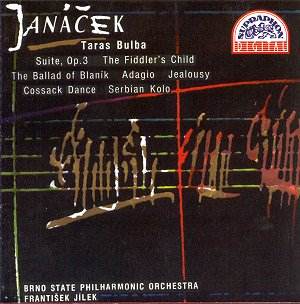It is a tribute to Janáček's
genius that we always think of him as a 20th century composer.
In fact he was aged 46 when the new century began, but of course he
continued to develop and the majority of his compositions of lasting
value were written in the final phase of his life.
The music collected here spans from the composer's
early years through to the rhapsody Taras Bulba, which he completed
in 1918. It is one of his greatest achievements, expressively and dramatically,
while also full of the most extraordinary orchestral subtleties. As
listeners we cannot know this music too well; each hearing and each
new performance will uncover more rewards. Thus it proves here, with
Jílek and the Brno orchestra reliable and committed interpreters.
There may not be the virtuosity of some performances, but the tempi
are well judged, the phrasing sensitive to the musical development,
and the power of the climaxes is undeniably dramatic (Try track 1: 7.04).
If there is a criticism it is that the ample acoustic which houses the
recording creates plenty of atmosphere, but has the effect of making
the impact less striking than it might have been. However, the experience
remains perfectly satisfying, and this is a rewarding performance.
If Taras Bulba is the strongest composition
on display, the remainder of the programme has abundant interest also.
Best of the other pieces are the two symphonic poems, The Fiddler's
Child and the Ballad of Blaník. The former has links
with Dvořák's symphonic poems, and
we should remember that Dvořák was Janáček's senior by only
thirteen years. Although the Violin Concerto (contained in volume 3
of this series) has made a recent and significant impression, Janáček
did write a substantial concertante part for the soloist in this
symphonic poem, as its title reminds us (Try track 12: 0.00). It is
also tightly dramatic and atmospherically takes up the opportunities
offered by a typical Czech legend.
The Ballad of Blaník, of course, has
links with Smetana's great cycle of symphonic poems, Ma Vlást.
Nor need this Janáček piece defer
to its predecessor (entitles simply Blanik). The orchestration
is particularly effective, and is one of the chief reasons why the work
confirms the composer's commitment to the nationalist cause in the days
before a nation state had been established (Try track 13: 0.00).
Of the remaining items, there are some characterful
dances and the Adagio. The latter was first performed in 1930,
two years after the composer's death. All these pieces date from the
1890s and are competent rather than inspired. Would we be interested
in them if they were by a lesser composer? The four-movement Suite also
dates from 1891, and like the Jealousy Overture (originally intended
for Jenufa) it has links with an opera, in this instance The
Beginning of a Romance. The music is attractive, engaging and, as
ever with this composer, rhythmically alive (Try track 5: 0.00). In
sum, this collection features idiomatic performances and an abundance
of fine music.
Terry Barfoot
